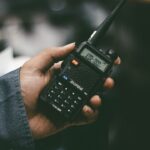Are you looking for the best thermal monocular to help you spot game from a distance at night?
Thermal imaging technology has revolutionized hunting, allowing hunters to see in complete darkness and detect animals that are hidden.
With so many options available, how can you determine which one is right for you?
In this blog post we’ll discuss what makes a great thermal monocular, explore different brands and models available, compare expensive vs affordable options and provide tips for using your new device. Whether it’s finding food or tracking prey, having an effective thermal monocular is essential if you want to be successful out in nature – let’s get started.
What is a Thermal Monocular?
Infrared technology is employed in thermal monoculars to identify heat signatures from the environment, enabling hunters and outdoors enthusiasts to detect game from far away even through barriers like foliage or fog.
It can be used for hunting, surveillance, and even navigation in low light conditions. Thermal monoculars are becoming increasingly popular among hunters and outdoors enthusiasts due to their ability to detect game from long distances and through obstacles such as foliage or fog.
The definition of a thermal monocular is simple:
it’s an optical instrument that detects infrared radiation emitted by objects in its field of view. By capturing this radiation, the device can create an image based on the temperature differences between objects within its range – allowing users to see what they otherwise wouldn’t be able to with just their eyes alone.
Benefits of using a thermal monocular include improved visibility at night or during inclement weather; better detection of animals or people hiding behind cover; increased accuracy when shooting at targets; and more efficient tracking of game over longer distances than traditional optics allow for.
Thermal imaging also allows users to identify potential hazards before they become visible with the naked eye – making it an invaluable tool for those who spend time outdoors in unfamiliar terrain.
Thermal monoculars are a great tool for hunters, outdoorsmen and recreation enthusiasts to use in order to detect heat signatures of animals or objects in the environment. By understanding how thermal imaging works, users can get an even better idea of how they can utilize their thermal monocular effectively with different modes and settings.
How Does a Thermal Monocular Work?
Thermal imaging technology has become an essential tool for hunters, sportsman and outdoors enthusiasts. Thermal monoculars are a type of imaging apparatus that give users the ability to discern heat signatures in their surroundings with remarkable precision and clarity.
To understand how these devices work, let’s take a look at the basics of thermal imaging technology.
At its core, thermal imaging works by detecting infrared radiation or “heat” emitted from objects in the environment. This is done through sensors known as microbolometers which measure temperature differences across surfaces and convert them into digital images on your display screen.
The hotter something is, the brighter it will appear on your display screen while cooler temperatures will be displayed as darker shades.
Thermal imaging can be a useful tool to detect living beings lurking in concealment, such as behind trees or shrubs; it works by detecting the higher body temperature of creatures compared to their environment, thereby alerting you to potential dangers before they get too close.
Additionally, certain models may even have built-in features such as night vision capabilities which can help further enhance your ability to see in low light conditions where regular cameras would fail miserably.
When picking a thermal monocular, there are some elements to think about, such as pixel count per inch, how much magnification it has and the breadth of vision. Depending on what kind of activities you plan on doing with your device these settings may vary significantly so make sure you do some research beforehand.
Additionally some models may also come with additional features like image stabilization which helps reduce any shaking caused by movement making it easier for users who might not have steady hands when looking through their device.
Once the appropriate model has been selected, it is essential to perform regular maintenance in order to ensure its optimal functioning and longevity. This includes cleaning lenses after each use and storing it away safely when not being used; both measures will help keep dust particles out of sensitive components, thus extending its life span considerably.
A thermal monocular can be a powerful tool for any hunter, sportsman or outdoors enthusiast. Understanding the mechanics of a thermal monocular can help you pick the ideal device for your activity. Now that we have discussed how they work, let’s explore what factors to consider when choosing one.
Choosing the Right Thermal Monocular for You
Selecting the appropriate thermal monocular for you necessitates taking into account a handful of essential elements.
First, evaluate your needs and budget. Consider what type of hunting or outdoor activity you’ll be using the device for and how much you’re willing to spend on it.
You don’t want to overspend if you only need basic features, but if you plan on doing more advanced activities like long-range shooting or night vision tracking then investing in a higher end model might be worth it.
Next, compare different brands and models of thermal monoculars. Look at reviews online from other users who have used the product before as well as any independent tests that may have been done by professionals in the field. Examine the various brands and models of thermal monoculars to determine which offers superior performance while still being affordable.
Finally, decide between expensive and affordable options when selecting a thermal monocular for yourself.
Some may opt for pricier models with extra features, but others might discover that more affordable selections can be just as effective while not draining their wallet. It is imperative to consider the features offered by each option and how they fit with your needs prior to making a choice, as cheaper items may lack certain aspects.
Making the right choice when selecting a thermal monocular is essential for any hunter or outdoors enthusiast. To ensure you get the most out of your purchase, here are some tips to consider when selecting a thermal monocular.
Tips for Using Your New Thermal Monocular
Setting Up Your Device Properly for Optimal Performance: Setting up your thermal monocular correctly is essential to get the most out of it. Read the guidebook thoroughly to get acquainted with all the elements and functions of your device.
Start by connecting any external power sources such as batteries or solar panels if applicable.
Once that’s done, adjust the settings on your device according to your needs. This includes setting brightness levels, contrast ratios, color palettes, etc., so you can view objects in different environments more clearly. You should also configure the zoom function so that you can see distant objects better without compromising image quality.
Learning How to Read Heat Signatures in the Environment:
Knowing how to interpret heat signatures is key when using a thermal monocular effectively. To do this accurately requires practice and experience reading different temperature contrasts in various environments like forests, deserts or snowfields at night time or during daylight hours.
Pay attention to details such as subtle changes in shade variations between hot and cold areas which will help identify potential threats faster than relying solely on visual cues alone.
Additionally, pay close attention when viewing large bodies of water since they tend to absorb heat differently compared other surfaces making them difficult targets for detection with a thermal monocular unless configured properly beforehand.
By following these tips, you can ensure that your thermal monocular is set up properly and functioning optimally. Now, let’s look at how to keep your thermal monocular in good condition and running smoothly.
Maintenance and Care for Your Thermal Monocular
Cleaning and Storing Your Device Properly:
It is important to keep your thermal monocular clean and stored in a safe place. To clean the lens, use a soft cloth or cotton swab with an alcohol-based solution such as rubbing alcohol or eyeglass cleaner. Avoid using harsh chemicals that could damage the device.
Make sure to store it in a dry area away from direct sunlight, dust, and moisture. Periodically inspect your thermal monocular when stored for long durations to guarantee no dust has settled on the lens or any other part of the device.
Troubleshooting Common Issues with Your Device:
There may be times when your thermal monocular isn’t functioning properly due to various issues like power loss or connection problems.
First off, make sure all connections are secure and tight before attempting any troubleshooting steps. If there is still an issue after checking these things then try resetting the device by turning it off completely then back on again after about 30 seconds have passed.
Additionally, if you notice any strange noises coming from within the unit then this might indicate something more serious so contact customer service for further assistance if needed.
FAQs in Relation to Best Thermal Monocular
What is the best thermal monocular on the market?
The Pulsar Helion XP50 is widely considered to be the best thermal monocular on the market. It features a 640×480 resolution display, 2.5-20x magnification range, and an impressive detection range of up to 2000m in total darkness. Its image quality is outstanding with clear details and high contrast even at long distances.
The integrated video recording capacity allows users to save snapshots or clips for later viewing or sharing with others.
Additionally, its one-shot zeroing feature makes sighting quick and easy while its recoil activated video (RAV) ensures that no important moments are missed when shooting from a rifle or shotgun. All these features make it an ideal choice for hunters looking for top performance in their thermal imaging device.
What should I look for when buying a thermal monocular?
When purchasing a thermal monocular, resolution should be taken into account for optimal viewing of targets in low light or total darkness.
Higher resolution will provide better clarity and detail when viewing targets in low light or total darkness. In addition, make sure to check for digital zooming capability, enabling you to get a closer look at your target without sacrificing image quality – up to 8x magnification.
Other features like video recording and still images can be helpful if you want to capture what you’re seeing while hunting. Ensure that the device is user-friendly to guarantee ease of operation in any situation.
What is the best thermal scanner?
The best thermal scanner for hunters and outdoors enthusiasts is the FLIR Scout TK. This handheld device provides crisp, clear images in total darkness up to 100 yards away. It has a temperature range of -4°F to 248°F, allowing you to easily identify game or track animal movement in any environment.
The intuitive design makes it easy to use with its one-handed operation and simple menu navigation. Its lightweight construction ensures portability while its rugged housing protects against bumps and drops during outdoor adventures.
With all these features combined, the FLIR Scout TK is an ideal choice for those looking for reliable performance when hunting or exploring nature’s wonders.
What is the best thermal imager for hunting?
The best thermal imager for hunting depends on the specific needs of the hunter. For those looking for a high-performance device with advanced features, FLIR Systems’ Scout TK is an excellent choice.
It offers exceptional image quality and long range detection capabilities, as well as multiple color palettes to choose from. The small size makes it easy to carry in a pocket or pack while still providing crystal clear images of game animals up to 100 yards away. The user-friendly design and economical cost make it an ideal selection for any dedicated hunter.
Conclusion
A thermal monocular is an invaluable tool for any hunter, sportsman or outdoors enthusiast. With the right information and comprehension of its operation, you can choose a thermal monocular that suits your requirements and budget.
Remember that proper maintenance and care are essential in keeping your device functioning optimally so make sure to read up on all manufacturer instructions before using it out in the field.



